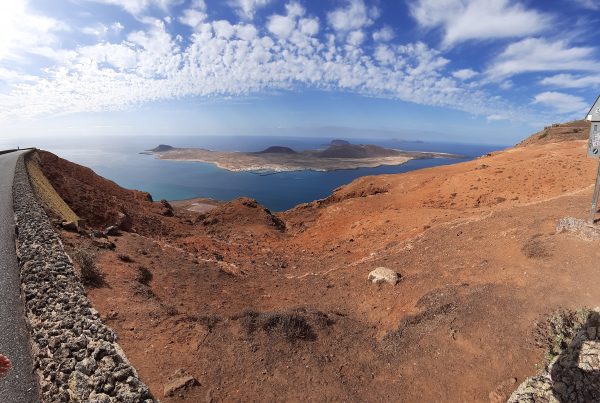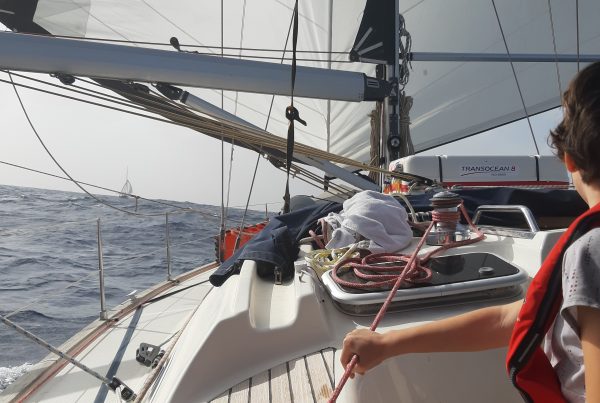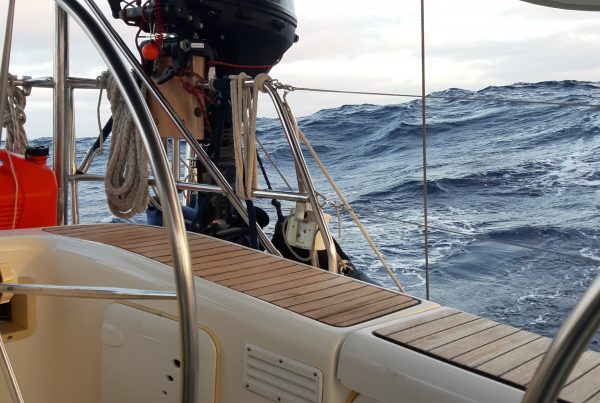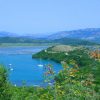Tuesday, Sep 17, 2019, 12:08 PM GMT+2, A-389, El Ejido, Andalusia, Spain
Today I’m on the bus from Malaga to Almeria, of which El Ejido is an Etobicoke if Almeria were Toronto. Otoka is just about done refit (apparently some fussing with rigging that would best were it “done right” is pushing back the original plan a day or two).
I’m glad that I wasn’t able to afford a direct flight to Almeria now; the extra day to get acclimatized was very interesting, and … I gotta say, “3 hour tour” (literally!) through this coastal countryside is … spectacular. I know enough about pictures to know that snaps through the window will never do it the slightest justice.
We’re talking terraced groves of trees, giant stands of palms, arid scrubland towering with white villas peeking out (some crisp, some crumbling), winding tracks through it all everywhere, crops under vast shade covers, views of the sea far below.
The sense of civilization having settled here long ago is palpable.
Which brings me to a thought I was having yesterday, in the old town of Malaga. Imagine what it must have been for the twin thrones of Spain in the late 1400’s — ruling over vast resources, feeling entirely invested in by God, feet firmly planted in a civilization — rich in history, yet light on archeology, that history remembered and shaped through the lens of a politically active priesthood* — and having the orient and new world opening before them, with only a handful of well-known competitors to contend with – the Portuguese (denied Gibraltar, forced to work their way down Africa, seeking the Orient, get scooped by Spain’s Columbus expedition!)…
I had a visceral sense of all that — Small wonder they felt like God’s instruments on earth, free to rule and conquer as they pleased, so long as it was in the name of Christ.
This is sometimes what is meant when one says “Nuthin.” to “What are you thinking?”. (Other times, it’s legitimately a complete zone out. Amazing how flexible language can be, yes?).
But I digress.
Let’s talk greenhouses/sunshade for crops. I mentioned that there was a lot of that several paragraphs back. I was wrong. There is a lot of Greenhouses squared, cubed, and squared again. Perhaps… square whatever large number you are now thinking of now several times. You may still be low. Also, El Ejido is not a suburb of Almeria — it’s a small town at the bottom of a field, actually. I think some images in from Google Earth might help make your noodle explode, perhaps like mine did just recently:

So, those are two big sections along the coast. At first glance, you might be thinking you are looking at an urban area, but no, all that white stuff is KM after KM of greenhouses.
When you are down on the ground, there is nothing but occasional roads, and endless walls of greenhouse walls.
For example:

Here is another sample of how this looks:

Not really sure what they are growing in there, but it certainly is on a scale that I find hard to comprehend. I hear that there are those with concerns about it, which seems hardly surprising.
Talking with Sarah and Nick, the find that as transients, moving from port to port that it’s disconcerting how easy it is to become very disconnected from the source of their food — out in BC, it’s a place that is tight knit, eco-centric, distant from urban centres, and has a whole lot of gardening and local farming operations, so it’s nearly impossible to live there, and not know a lot about the local food options; similarly in Kitchener-Waterloo region, there is a thriving network of local farm-to-table supply chain built; it’s pretty easy to ignore if you don’t care, but it’s also very available to anyone who takes a modicum of time to dig into it.
I think this isn’t necessarily about “100 mile diet” type principals; it’s about how you figure out what you are going to cook tonight, and a feeling being part of the place that you are in; Sarah, Nick and I are all people who both love to travel … and are basically home-bodies who cherish being deeply connected to things.
This is why The Boat, as well — it’s a home you take with you, where you can still have everything just so, and you can build a family of other boats around you. I presume something similar happens in the RV communities as well.
Speaking of The Boat, boats love being maintained. They cry out for maintenance, and for everything struck from the list, at least one new thing is found. Otoka has been in port for the last two weeks getting some big work done — as fortune would have it, a rigger in back in Italy put a whole bunch of new stuff up, and it just wasn’t performing right, and Nick was looking at it, knowing in his bones that stuff just wasn’t as it needs to be.
The folks here in El Ejido apparently also seemed adept at telegraphing a deep and abiding suspicion that they couldn’t be trusted on this score either.
Soooo….. The bad news is that we’re going to be in port a few more days at least.
The great news is that a Cheery Australian Bloke who is quite skilled, happy to explain exactly what he’s doing, discourse on options, and tell you freely that what you have there is just fine, and that here could be a problem, has shown up and in the space of one day, sorted the rigging such that it feels right again. There are some issues remaining, but the perception of relief that things seem proper again, and that the right bloke has been found, is palatable.

And yes, that is a digital guitar tuner being used to verify that the tension between the port and starboard shrouds are indeed matched. If memory serves, they are a “G”.

This is a more general view of the boat. It is 47 ft long, and about 14 wide. I’ll do a tour soon. I’ve only got the “living on board in port tour” so far, and we’ve got other tours like General Systems, Nav, Rope Handling / Sailing Operations, and Emergencies at Sea type tours, each of which seem to me like they could be interesting in their own right.
I was introduced to Dyneema rope — very strong, very light and soft; apparently strong enough that people use it for rigging race boats. Nick notes that with kids running around and marinas in general, a rig that can be destroyed by a 10 year old with a pocket knife isn’t reassuring, so he wasn’t overly tempted to swap out his stainless wire ropes for fibre.
Nick also noted that, while reading up on how kids on boats works, he saw an entertaining story of how one sailing family was surprised when their 5 or 6 year olds drilled a hole through the bottom of the boat with a manual auger. When I was looking in the Otoka engine compartment, I noticed some wooden bungs cable tied in an easy to grab spot, and asked about them — and Nick said “in case you need to stop up a through-hole in a hurry.
I suppose these folks had to find one of those bungs and get that hole blocked!
I’ve got my little office set up at the Nav Station:

The sun tries to make a go for me mid-afternoon (morning in Ontario), but closing the top part of the main hatch shows it who’s boss.
I almost missed, in talking about food earlier, that this coastal living does have its perks — for next to nothing Sarah was able to make a great batch of ceviche:

And Talia has no room in her cup of care for where her tangerines come from, so long as they keep coming:

Other good news — a Gelato shop with about 26 great flavours, right beside a frozen yoghurt shop, right beside an ice cream shop or something is located just a couple of jetties over. My nieces are lovely company, and extending me all the benefits of the doubt regarding the possibility that I may indeed be as interesting, nice and snarky as they recall. We’re gonna ISO 9001 this — we gonna be meeting and exceeding expectashuns, yo. Cool uncle on the block here. </Gang Signs>
Cool uncle who knows how to combine Throwing Down with HTML, no less. I Got This. For your little moment of “Isn’t that an Interesting Detail”, we’ll close with this picture:

I guess REGULAR Hospital symbols are not cool enough for this region of Spain — better change the colour of the cross, and add a thin, uncomfortable looking bed!
Cheers, all!
-Cedric
———– foot notes ————-
- I think “Catholic” was pretty much the only Christian force that mattered, at least in Western Europe around 1400 and 1500’s; The Moors (Moops?) were losing in the region, and Luther nailing his “suggestions for improvement” was more like 1600’s, and I think that’s when people really got the idea that “Hey, we should have lots and lots and lots of Christian sects”, and then it became like the modern version of Being a Celebrity, and Having a Charitable Foundation.**
- * Actually, you know what, Church history is “detailed and nuanced”. Let’s just leave it at “I don’t know nuthin’”, and leave it at that. I mean, Anglicans split from the main church hundreds of years before that, so Luther can hardly be said to have invented “splintered Christianity”.*** * ** Also, there are people receiving these missives that actually know this stuff, so… maybe just leave a conversation starter, and maybe I’ll learn something if they write back.






